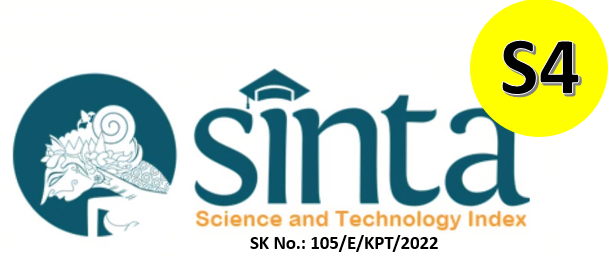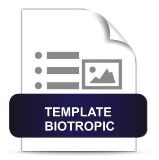Analysis on Nutrient Contents & Food Safety of Local Gatul Fish (Xiphophorus hellerii) as Potential Food Resources
DOI:
https://doi.org/10.29080/biotropic.2022.1.1.1%20-%2011Keywords:
Gatul Fish, Protein, Fat, Potency, Food SafetyAbstract
Gatul fish is one abundance of freshwater introduced fish that can be found in all tropical and subtropical area. One species of Gatul fish has been found in Telaga Sari, Pasuruan Regency is Xiphophorus hellerii. This fish are live bearers, dimorphism sexual, modification of anal fish called gonopodium and pregnant & birthing female. Until now, its potential as a food resource is not known. This research aimed to analyze nutrient contents of Gatul fish as food resources based on the protein and fat content and to evaluate the food safety based on the content of plumbum, cadmium, and mercury. The sample of Gatul fish was collected from Telaga Sari based on four Xiphophorus helleri (female and male). The protein content was analyzed using Kjeldahl method, while the content of fat was analyzed using soxhlet method. In addition, the level of plumbum, cadmium, and mercury in the flesh Gatul fish were tested using atomic adsorption spectroscopy (AAS). The results showed that both of the flesh Gatul fish (male and female) contained high protein for orange male (20.389±0.238); orange female (20.256±0.07); gray male (21.3557±0.25), and gray female (20.5687±0.10) respectively. The fat of flash Gatul Fish both male and female content in Gatul fish ranged from 2.966%-3.934%. It seems that the nutrient content outweighs the content of others commercial consumed fish. The content of plumbum in the flesh fish were 0.712±0.0116 ppm; chadmium were 0.128±0.129, Meanwhile, the content of mercury in the flesh fish were 0.0039±0.0017. These numbers are considerably lower that the level permitted. Hence, it can be concluded that Gatul fish has potency as a cheap, safe, and nutritious of food resource
Downloads
References
Adam, M. A., Maftuch, M., Kilawati, Y., & Tahirah, S. N. (2018). Analysis of Heavy Metal Pollutant in Wangi River Pasuruan and Its Impact on Gambusia affinis. Jurnal Pembangunan dan Alam Lestari, 9(2), 120–128. https://doi.org/10.21776/ub.jpal.2018.009.02.09
Ambarwati, R., Rahayu, D. A., & Faizah, U. (2019). The Potency and Food Safety of Lamp Shells (Brachiopoda: Lingula sp.) as Food Resources. J. Phys.: Conf. Ser., 1417, 12039. https://doi.org/10.1088/1742-6596/1417/1/012039
Argota, G., González, Y., Argota, H., Fimia, R., & Iannacone, J. (2012). Development and bioaccumulation of heavy metals in Gambusia punctata (Poeciliidae) before the effects of water pollution. Revista Electronica de Veterinaria, 13(5).
Arifiyanto, A., Apriyanti, F. D., Purwaningsih, P., Kalqutny, S. H., Agustina, D., Surtiningsih, T., Shovitri, M., & Zulaika, E. (2017). Lead (Pb) Bioaccumulation; Genera Bacillus Isolate S1 and SS19 As a Case Study. AIP Conference Proceedings, 1854(1). https://doi.org/10.1063/1.4985394.
Baki, M. A., Hossain, M. M., Akter, J., Quraishi, S. B., Haque Shojib, M. F., Atique Ullah, A. K. M., & Khan, M. F. (2018). Concentration of heavy metals in seafood (fishes, shrimp, lobster and crabs) and human health assessment in Saint Martin Island, Bangladesh. Ecotoxicology and Environmental Safety, 159(December), 153–163. https://doi.org/10.1016/j.ecoenv.2018.04.035.
Bandyopadhyaya, S., Vankayalapati, R., Rajanna, L., & Kulkarni, S. (2013). DNA barcoding and its applications - A critical review. Cmrims J. Res. and Dev, 1(1), 77–81. https://www.researchgate.net/publication/285322603.
Dika, F. A., Brahmana, E. M., & Purnama, A. A. (2017). Uji Kandungan Protein dan Lemak pada Ikan Bada (Pisces Rasbora Spp.) Di Sungai Kumu Kecamatan Rambah Hilir Kabupaten Rokan Hulu. Jurnal Mahasiswa FKIP Universitas Pasir Pengaraian, 3, 1–5.
Hafiludin. (2011). Karakteristik Proksimat dan Kandungan Senyawa Kimia Daging Putih dan Daging Merah Ikan Tongkol (Euthynus affinis). J. Kelautan, 4(1), 1–10.
Hafiludin. (2015). Analisis Kandungan Gizi Pada Ikan Bandeng Yang Berasal Dari Habitat Yang Berbeda the Analysis of Nutritional Content of Milkfishes Which Come From Different Habitats. Kelautan, 8(1), 37–43. http://journal.trunojoyo.ac.id/jurnalkelautan.
Haryono & Tjakrawidjaja, A. . (2006). Morphological Study for Identification Improvement of Tambra Fish (Tor spp.: Cyprinidae) from Indonesia. Biodiversitas Journal of Biological Diversity, 7(1), 59–62. https://doi.org/10.13057/biodiv/d070115.
Izwardy D, Mahmud MK, Hermana, & Nazarina. (2017). Tabel Komposisi Pangan Indoensia 2017. In Kementerian Kesehatan Republik Indonesia.
M Ervany Eshmat, G. M. dan B. S. R. (2014). Analisis Kandungan Logam Berat Timbal (Pb) Dan Cadmium (Cd) Pada Kerang Hijau (Perna Viridis L.) Di Perairan Ngemboh Kabupaten Gresik Jawa Timur. 6(1), 634. https://hsgm.saglik.gov.tr/depo/birimler/saglikli-beslenme-hareketli-hayat-db/Yayinlar/kitaplar/diger-kitaplar/TBSA-Beslenme-Yayini.pdf.
Mardiana, N., Waluyo, S., & Ali, M. (2014). Analisis Kualitas Ikan Sembilang ( Paraplotosus Albilabris ) Asap Di Kelompok Pengolahan Ikan “ Mina Mulya ” Kecamatan Pasir Sakti Lampung Timur Analysis Of The Quality Of Smoked Whitelipped Eel Catfish In “ Mina Mulya ” Fish Processing Group , PASIR SAKT. Jurnal Teknik Pertanian Lampung, 3(3), 283–290.
Mahmud, M. K., dkk. 2005. Daftar Komposisi Bahan Makanan (DKBM). Jakarta: Persatuan Ahli Gizi Indonesia (PERSAGI).
Muchlisin, Z. A., & Azizah, M. N. S. (2010). Diversity and distribution of freshwater fishes in aceh water, Northern-Sumatra, Indonesia. In International Journal of Zoological Research (Vol. 6, Nomor 2, hal. 166–183). https://doi.org/10.3923/ijzr.2009.62.79
Munthe, I., Isa, M., Winaruddin, W., Sulasmi, S., Herrialfian, H., & Rusli, R. (2016). Analisis Kadar Protein Ikan Depik (Rasbora tawarensis) di Danau Laut Tawar Kabupaten Aceh Tengah. Jurnal Medika Veterinaria, 10(1), 67–69.
Nugroho, ED, Rahayu, DA., AMin, M., Lestari, U. (2015). Journal of Biological Researches. Journal of Biological Researches, 21(1), 41–45.
Nurviana, Y., Brahmana, E. M., Purnama, A. A., Pengaraian, U. P., Pengaraian, U. P., & Pengaraian, U. P. (2017). Analisis Kandungan Protein dan Lemak pada Ikan Selais disungai Kumu Kabupaten Rokan Hulu Provinsi Riau. Journal, 22–23.
Rahayu, DA., Listyorini, D., I. (2013). Morphological Study for Identification Improvement of Poeciliidae Family Based on Gonopodium structures and Morphometric analysis. Journal of Tropical Life Science, 3(1), 91–95. https://doi.org/10.11594/jtls.03.02.04.
Rahayu, D. A., Nugroho, E. D., & Listyorini, D. (2019a). DNA Barcoding Ikan Introduksi Khas Telaga Sari, Kabupaten Pasuruan. Biotropika: Journal of Tropical Biology, 7(2), 51–62. https://doi.org/10.21776/ub.biotropika.2019.007.02.2.
Rahayu, D.A., Jannah, M.,Winaris, N., Listyorini, D,. (2010).The Phylogenetic of Gatul Fish (Xiphophorus sp.) in Sari Lake Purwodadi, Pasuruan Regency. Proceeding of International Meeting of Association Tropiocal Biology and Conservation. Bali.
Rahayu, D. A., Nugroho, E. D., & Listyorini, D. (2019b). Studi Morfologi Dan Fenetik Taksonomi Ikan Introduksi Khas Telaga Sari, Pasuruan. Borneo Journal of Biology Education, 1(1), 18–33. https://doi.org/10.52222/bjbe.v1i1.958.
Rajeshkumar, S., & Li, X. (2018a). Bioaccumulation of heavy metals in fish species from the Meiliang Bay, Taihu Lake, China. Toxicology Reports, 5(January), 288–295. https://doi.org/10.1016/j.toxrep.2018.01.007
Rajeshkumar, S., & Li, X. (2018b). Bioaccumulation of heavy metals in fish species from the Meiliang Bay, Taihu Lake, China. Toxicology Reports, 5(February), 288–295. https://doi.org/10.1016/j.toxrep.2018.01.007.
Ramlah., Eddy, S., Hasyim, Z., & Hasan Munis Said. (2016). Perbandingan Kandungan Gizi Ikan Nila Oreochromis niloticus Asal Danau Mawang Kabupaten Gowa dan Danau Universitas Hassanuddin Kota Makassar Comparison of Nutritional Content of Tilapia Oreochromis niloticus from Mawang’s Lake Gowa and Hassanuddin Univers. Jurnal Biologi Makassar (Bioma), 1(1), 39–46.
Rashed, M. N. (2001). Monitoring of environmental heavy metals in fish from nasser lake. Environment International, 27(1), 27–33. https://doi.org/10.1016/S0160-4120(01)00050-2.
Rochyatun, E., & Rozak, A. (2007). Pemantauan Kadar Logam Berat Dalam Sedimen Di Perairan Teluk Jakarta. 11(1), 28–36. https://doi.org/https://doi/org/10.7454/mss.v11i1.228
Sagita, R., Suwondo, & Yustina. (2017). Analisis kandugan logam berat timbal (Pb) dan kadmium (Cd) pada perairan Sungai Sail Kota Pekanbaru berdasarkan bioindikator keong mas (Pomacea canaliculata) sebagai rancangan modul biologi konsep pencemaran di SMA. Jurnal Online Mahasiswa Fakultas Keguruan dan Ilmu Pendidikan Universitas Riau, 4(2), 1–13.
Samsundari, S. (2007). Identifikasi Ikan Segar Yang Dipilih Konsumen Beserta Kandungan Gizinya Pada Beberapa Pasar Tradisional di Kota Malang. Universitas Stuttgart, 14(1), 41–49.
Standar Nasional Indonesia (SNI) 2009 Standar nasional Indonesia nomor 7387.2009 tentang batas maksimum cemaran logam berat dalam pangan (Jakarta: Badan Standar Nasional)
Thilsted, S. H., James, D., Toppe, J., Subasinghe, R., & Iddya, K. (2014). Maximizing the contribution of fish to human nutrition. ICN2 Second International Confrence on Nutrition: better nutrition better lives, November, 16.
Yousif, R., CHOUDHARY, M. I., AHMED, S., & AHMED, Q. (2021). Review: Bioaccumulation of heavy metals in fish and other aquatic organisms from Karachi Coast, Pakistan. Nusantara Bioscience, 13(1), 73–84. https://doi.org/10.13057/nusbiosci/n130111.
Downloads
Published
How to Cite
Issue
Section
License
Copyright (c) 2022 Dwi Rahayu, Miftahul Jannah, Saibatul Linadziroh, Dwi Litsyorini

This work is licensed under a Creative Commons Attribution-NonCommercial-ShareAlike 4.0 International License.













